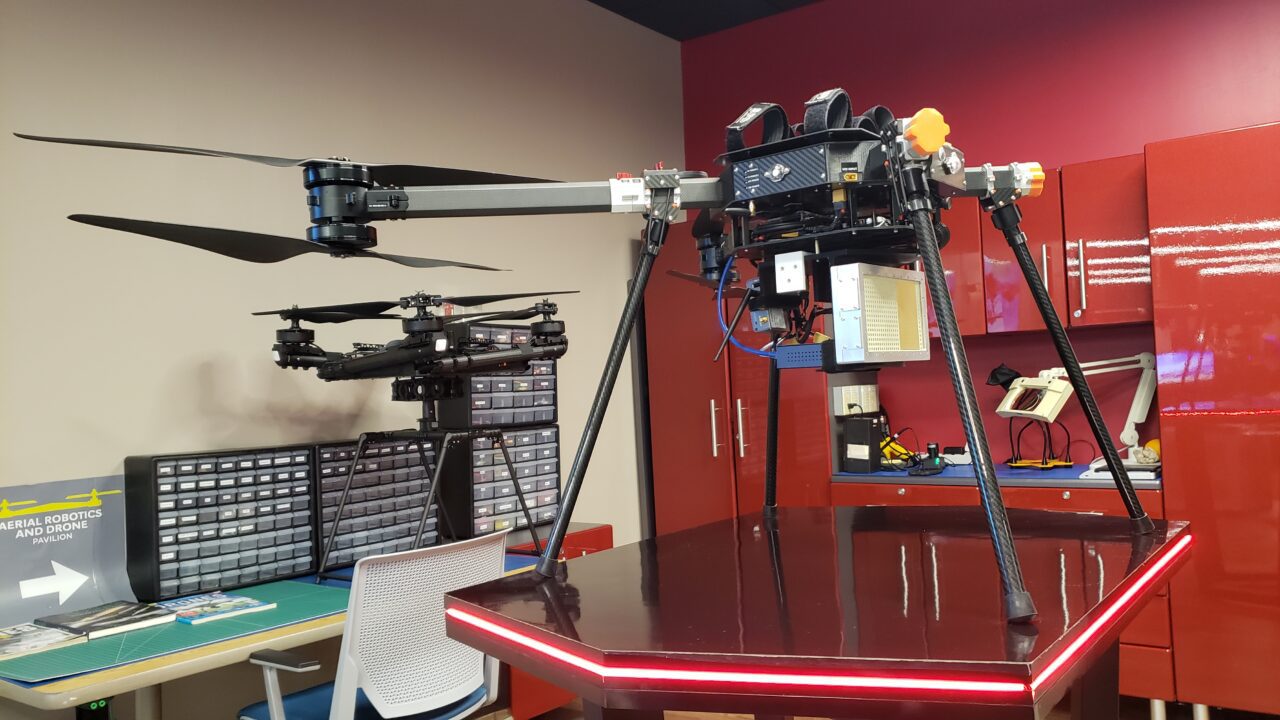
Honeywell Aerospace is currently working on version 2 of its IntuVue RDR-84K radar system, which can be seen mounted on the drone in the image above, taken at the Advanced Air Mobility Lab in Phoenix. (Photo courtesy of Honeywell Aerospace)
Honeywell Aerospace has unveiled a new lab at its facilities in Phoenix, Arizona, featuring the company’s latest advanced air mobility (AAM) solutions. The lab has not formally opened yet, but the Honeywell team hosted a preview event on April 12. Attendees were able to experience three different flight simulators and see some of Honeywell’s systems developed specifically for unmanned aerial systems (UAS) and for vertical take-off and landing aircraft.
The AAM lab featured a space dedicated to its RDR-84K radar system, which was presented by Lead Systems Engineer Larry Surace and by Andrew Baker, Senior Advanced Systems Engineer for Urban Air Mobility. The first version of Honeywell’s RDR-84K radar system recently demonstrated autonomous detect-and-avoid (DAA) capabilities during a series of tests completed with a second non-cooperative drone in Arizona. The DAA algorithm calculates the speed of moving targets to determine when it needs to change direction in order to avoid collision. “There was no intervention from the pilot, who relinquished control of the drone to the radar,” stated Surace during the preview of the AAM lab. “We flew it on multiple missions, at various altitudes, and at different angles. That allowed us to characterize how the radar was performing when it was put on a real drone.”

Honeywell’s AAM lab at its facilities in Phoenix, Arizona, featured multiple flight simulators showcasing their simplified vehicle operations (SVO) and other technological developments like its radar system. (Photo courtesy of Honeywell Aerospace)
Next, they plan to perform tests with the radar against multiple drones in multiple different scenarios. The radar is capable of detecting up to 30 moving targets at the same time. A more immediate goal for the team is to release the second version of the radar, which they expect to do by the end of June.
The radar is compact and capable of detecting objects at a distance of 3 kilometers. The second version of the RDR-84K radar that is in the works right now will weigh about 1.5 pounds, a significant weight reduction from the first version. Although Honeywell has built a wide variety of radar systems for decades, the RDR-84K model was designed specifically for drone DAA applications. Its other features include ground mapping, weather detection, obstacle detection on the ground, and detection of multiple targets.

The RDR-84K radar system on display at Honeywell’s AAM lab (Photo taken by Jessica Reed)
“We’re expecting a 2025 timeframe or sooner to integrate it on vehicles like drones for delivery,” Surace remarked, but the timeline will be driven by the market demand for the radar. Aerospace company Airflow announced a new partnership with Honeywell in October 2021 in which Airflow selected the RDR-84K as the radar system that it will integrate into its electric short take-off and landing (eSTOL) aircraft.
Potential customers have also expressed interest in using the radar system for search and rescue operations, Surace noted, especially those taking place over water. “We are targeting the advanced air mobility market for our OEMs that are asking for this type of capability. We design for certification, and we’re in the process of working with the committees to understand how to get it certified, to show it will perform as designed in a safe manner. We work very closely with the FAA, and they give us suggestions for how to prove that we’re safe.”
Andrew Baker emphasized the engineering involved in determining how to fly the radar. “You can’t just google how to put a radar on a drone,” he explained. “Cameras and LIDAR [light detection and ranging] are very common payloads for UAVs, but not radars.”
An important capability that Baker highlighted is that a radar technician can remotely connect to the RDR-84K radar while it is in flight and quickly change various parameters, meaning that the team doesn’t waste time bringing the vehicle back to the ground. Average flight time with the model performing these tests is just 18-20 minutes, so every moment of a flight test is valuable.